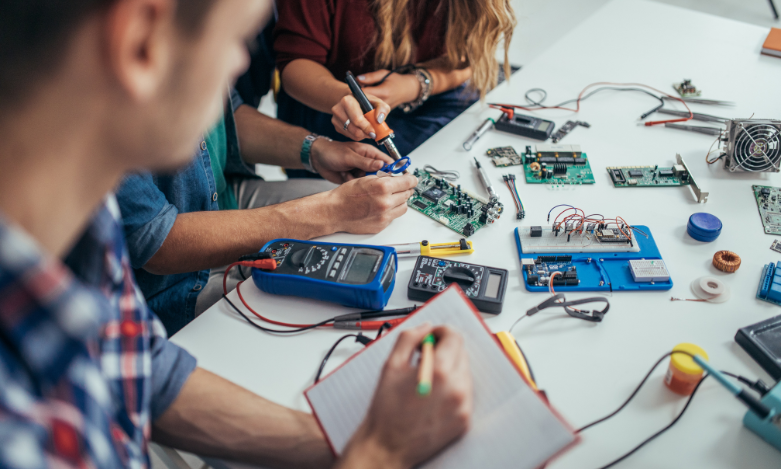Human Cardiovascular Simulation Device with Circaflex, Single-Board RIO, and LabVIEW
- Oct 26, 2022
- 3 min read
Updated: Mar 27, 2024
Left: Califia Patient Simulator controlled by Circaflex, in use at a university surgical training lab.
Right: Califia controls a pig’s heart to emulate various clinical scenarios.
"We couldn't have found a better partner for this collaboration. Cyth took our concepts and developed a working prototype quickly and with remarkable accuracy. In addition, by using Circaflex they have made it possible to add sensors or actuators in a seemingly effortless way, facilitating expansion and evolution of our product."
Richard Tallman Ph.D. CEO BioMed Simulation, Inc.
The Challenge
A designer and manufacturer of medical simulation equipment approached us about the need for a system to simulate the cardiovascular function of the human body.
The Solution
Using our Circaflex embedded control board and LabVIEW software, we were able to create a life-like cardiovascular simulator that recreates a wide variety of clinical scenarios including cardiopulmonary bypass (CPB).
The Story and The Cyth Process
BioMed Simulation, Inc., a designer, and manufacturer of medical simulation equipment approached us about a system that could simulate human cardiovascular activity. Their system – The Califia Patient Simulator – needed to be able to recreate a wide variety of clinical scenarios, including cardiopulmonary bypass (CPB).
Our engineering team recognized the benefits of having a versatile system that could be reprogrammed to emulate any ailment or cardiovascular condition. To provide these benefits we utilized Circaflex, our embedded control system.
To build the system our team began by using the Circaflex 540. Circaflex is a circuit board that interfaces the NI Single-Board RIO with all the sensor controls the Califia requires. The Circaflex and NI sbRIO monitor and control all functions of the Califia device which is crucial for its ability to simulate various medical scenarios.
Left: Circaflex embedded control board in use in the Califia Patient Simulator.
Right: The Califia unit provides heart rate readouts to an operating room (OR) monitor.
The Califia Patient Simulator contains many features that place it at the cutting edge of medical simulation equipment. The first of which is its ability to realistically simulate blood flow to and from a heart. It does this by containing a 2-liter tank for liquid which it controls with an inlet and outlet valve. A peristaltic pump directed by a stepper motor creates the pumping and draining actions required to accurately emulate the function of a human heart. All the motor controls are preprogrammed using LabVIEW. The Circaflex’s high-speed communication allows it to have a custom closed feedback loop constantly reporting the status of system motors and sensors back to the control boards. The system is then able to make the smallest of adjustments in real-time to make sure the simulation’s accuracy remains constant over a duration of time.
The Circaflex control board communicates with an array of devices in the Califia simulator including:
Flow meters
Liquid level sensors
Pressure sensors
Peristaltic pumps
Flow control valves
These sensors, motors, actuators, and valves enable the Califia unit to simulate medical scenarios, including Cardiopulmonary Bypass (CPB). CPB is a technique in which a patient’s heart and lungs are controlled and monitored during surgery to ensure proper blood circulation. In the past, gaining such experience for medical staff and students was only possible through shadowing a live operation. Thanks to Califia and the technology it brings forth medical staff and students are provided a way to work through real-world clinical scenarios themselves.
Another area in which the Califia Patient Simulator excels is in its ability to provide a large variety of simulated clinical scenarios. It can accurately simulate scenarios from high blood pressure and blood clots to even cardiac arrest. It achieves this through its high level of programmability. Our engineering team was able to use LabVIEW software to define a set of parameters by which the Califia functions. The unit is then able to self-adjust its function of base parameters to emulate whichever scenario the user requests. It is able to do this with remarkable consistency and repeatedly which has solidified its trust in university and medical settings alike.
Delivering the Outcome
Overall, the high-speed communication and control capabilities of the Circaflex and NI sbRIO control boards help provide the value Califia brings to the world of medical simulation. By precise control of motors, sensors, and valves and by enabling rapid deployment, the Ciraflex platform helped Califia evolve from a proof of concept to a final design in a matter of weeks. Califia is currently supporting medical staff and students in surgical laboratory settings, and likewise is helping prepare future medical professionals for the real-world scenarios they will encounter.
Technical Specifications
1 x Circaflex 577
1 x NI Single-Board RIO 9603
1 x Peristaltic Pump
1 x Stepper Motor
1 x Air/Water Flow Sensors with 0 to 5 Vdc Output
1 x Flow Meter
1 x RTD Sensor
1 x Pressure Sensor












